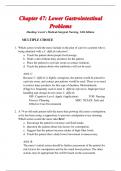Other
Study/ Revision notes for CIE AS History 9489_Modern Europe, 1750–1921 The Russian Revolution, 1894–1921
- Course
- Institution
- Book
These revision notes follow the updated CAIE A-level History 9489 syllabus and scheme of work for for Paper 1/2: EUROPEAN HISTORY, RUSSIAN REVOLUTION, 1894–1921. Easy to follow, clear and very detailed notes that cover all the core content topics, with exam guidance, structure, sample answers, s...
[Show more]













